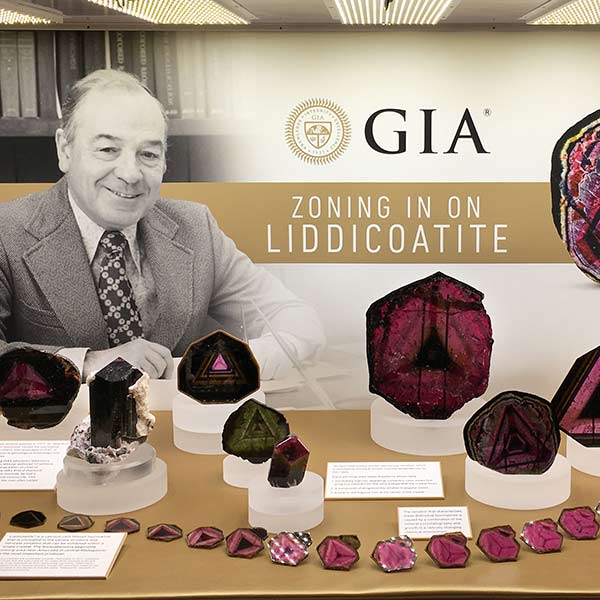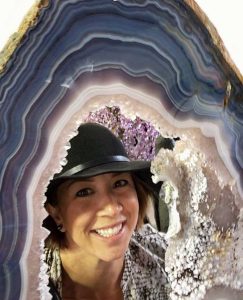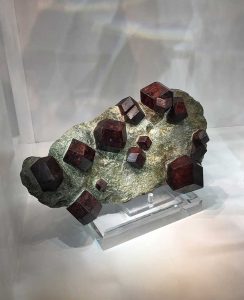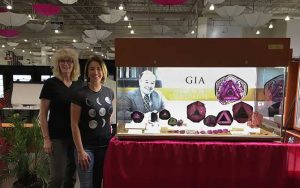
Anyone who’s been to Tucson in February knows that “Tucson gem show” is a misnomer. In late January and February, 47 shows set up shop in the city! From the city’s premier event, the AGTA GemFair at the Tucson Convention Center, to more offbeat satellite shows such as Westward Look or the Kino Gem & Mineral Show (aka Electric Park at the Kino Sports Complex), the selection is vast, diverse, and downright mind-boggling. After more than 15 visits to Tucson, I still can’t wrap my head around all the city has to offer during gem season.
But I know one person who can.
From Jan. 30 to Feb. 12, McKenzie Santimer, manager of museum exhibits and in-kind gifts at the Gemological Institute of America in Carlsbad, Calif., scoured the shows for stones and mineral specimens to bring back to campus. Together with museum curator Terri Ottaway, she sussed out the gem world’s newest, coolest finds; made a few purchases; and assessed current pricing to update the value of GIA’s permanent collection, which includes about 1,000 pieces on display in Carlsbad and about 100 at the New York City campus.

McKenzie Santimer, manager of museum exhibits at GIA, posing behind a geode slice while shopping in Tucson (photo courtesy of McKenzie Santimer/GIA)
Here, Santimer (who also happens to be a good friend of mine!) shares her takeaways from this year’s gem extravaganza. (Editor’s note: This interview has been edited and condensed for clarity.)
On why Tucson matters
“The thing about Tucson is that it’s where you learn about new finds coming out of the earth. Last year and the year before, every booth we went into, there was some form of liddicoatite. This year, nothing. Sometimes, collections come up for sale because there was a death. That’s exciting because we never know what’s going to come up. That’s the fun part.
“We are always looking at cut stones. Our collection is based on education. We’re always looking for large sizes to show the true colors and breadth these gems come in. You’re never going to find a really large ruby. But in minerals, you get more bang for your buck. In our collection we have a lot of gems, minerals are second, and jewelry is third.
“We generally have everything that can be cut, even cut sulfur. We have all the ‘weirdites’ as we call them. We’re always trying to find a mineral, a cut piece, and a piece of jewelry. That would be the trifecta: the rough, the cut, and the jewelry. Our student body consists of geologists as well as people coming from the jewelry and diamond side, so it’s nice to show all sides of it.”
On the massive geode you can expect to see at this year’s Symposium
“Tucson presents an opportunity to fill gaps in our collection but also, it opens our eyes to new and big things. This year, we bought a giant 16-sliced geode—all from one piece—that will be displayed in our Apex (the café area near the entrance). The slices go from 14 inches tall to 6-foot-plus. It’s a banded quartz agate: blue, pink, and white. We’re looking for the wow factor, and we’re always wanting to bring a slice of Tucson back to GIA. It took us a while to negotiate. But it’s ours now.
“The geode is from Brazil originally. Terri and I walked into Electric Park with [GIA senior vice president and chief marketing officer] Kathryn Kimmel. There was big sign that said, ‘We’re selling this as a set.’ I looked at her and said, ‘Apex. Symposium.'”
(Editor’s note: The 2018 GIA Symposium takes place in Carlsbad Oct. 7-9. See more details here.)
On why dealers often prefer selling to GIA
“The next day we went to Westward Look, the high-end mineral show. We looked at some killer garnets. (The garnet case in our hallway niche is pretty tired. We found some amazing spessartine and almandine garnets. They weren’t on our wish list, but we’re kind of always looking.)

Large almandine garnet crystals in schist from Tyrol, Austria, found at the Westward Look show in Tucson (photo courtesy of McKenzie Santimer/GIA)
“We start the dialogue. Dealers know us and know that we’re not going to cut the minerals up or turn them into jewelry. They know their piece will stay intact. They’re educators in a different realm; they know it’s going to good eyes and education.
“We’re also shopping for our New York campus, always trying to find something to wow New York, which is one of the harder things to do. How do you compete with Fifth Avenue?”
On GIA’s up-and-coming museum
“The museum is invited to TGMS, the Tucson Gem and Mineral Show, and we have a case there. It takes place at the convention center after AGTA. They change the carpet, put up different umbrellas, it’s a whole different look and vibe.

“Zoning in on Liddicoatite” case at the TGMS 2018 show, designed by GIA curator Terri Ottaway and manager of museum exhibits McKenzie Santimer (photo courtesy of McKenzie Santimer/GIA)
“It’s a public show with paid admission. Many of the museums are invited: the Smithsonian, Harvard, LA County, Carnegie. As a young museum, we’re also trying to show we have a collection. People just think of us a school and a lab, but we’re also a growing museum. In 2000, when I was first at GIA with [former museum director] Elise Misiorowski, we were just decorating the periphery of the building. Now we do exhibits like last fall’s Jewels of India. Now we have docents and self-guided tours, which began in 2005.”
On tips for putting together a great in-store gem display
“A lot of retailers are starting to get creative. As part of our retail support program, we have great images of birthstones they can use in store to enhance, say, the July birthstone, so they can say, ‘Hey, it also comes in rough, and in these different shades.’ I think a lot of people are trying to be creative and use organic materials like paper and wood in their displays.
“One of the most important things is having really good lighting. Also, you don’t want your props and auxiliary materials to outshine your jewelry. I’d say sometimes less is more. It’s really about the audience you have. In Texas, you might want to have something that speaks to that area, your local audience. The point is: Have fun!”
(At top: The liddicoatite case at the TGMS 2018 show designed by GIA curator Terri Ottaway and McKenzie Santimer; photo courtesy of McKenzie Santimer/GIA)
- Subscribe to the JCK News Daily
- Subscribe to the JCK Special Report
- Follow JCK on Instagram: @jckmagazine
- Follow JCK on X: @jckmagazine
- Follow JCK on Facebook: @jckmagazine